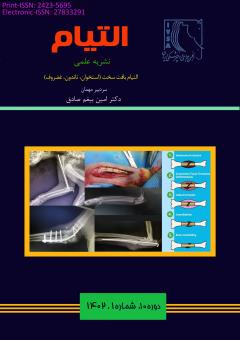معاینه ارتوپدی اندام قدامی در دام کوچک
محورهای موضوعی : علوم جراحی دامپزشکی شامل جراحی های بافت های سخت و نرمحمیدرضا مسلمی 1 , نوید احسانی پور 2 , فائزه عمارلو 3
1 - استادیار، گروه علوم درمانگاهی، دانشکده دامپزشکی، دانشگاه سمنان، سمنان، ایران
2 - دانشجو، گروه علوم درمانگاهی، دانشکده دامپزشکی، دانشگاه سمنان، سمنان، ایران
3 - دانشجو، گروه علوم درمانگاهی، دانشکده دامپزشکی، دانشگاه سمنان، سمنان، ایران
کلید واژه: معاینه ارتوپدی, اندام قدامی, دام کوچک,
چکیده مقاله :
لنگش یک مشکل شایع در طب حیوانات کوچک است. از آنجایی که حیوانات به خصوص سگ ها، بیشتر وزن خود را توسط اندام-های قدامی تحمل می کنند، معاینه اندام حرکتی قدامی ضروری بنظر می رسد. تشخیص و درمان لنگش در اندام قدامی اغلب می-تواند چالش برانگیز باشد. بیماران، معمولاً درد آشکاری را در ملامسه نشان نمی دهند بنابراین تشخیص ضایعه به راحتی امکان پذیر نمی باشد. بررسی علت لنگش و مکانهای آناتومیکی ضایعه، بر اساس سن، نژاد و سبک زندگی حیوان متفاوت است. بنابراین، معاینه سیستماتیک ارتوپدی برای اطمینان از ارزیابی تمام ساختارها و از دست نرفتن بخشی از آن مهم است. معاینه ارتوپدی شامل اخذ تاریخچه، مشاهده راه رفتن، تحلیل و ارزیابی گام و معاینه بالینی بیمار می باشد. در ابتدا سابقه لنگش، تشخیص و درمان های قبلی و میزان تأثیر آنها، وجود هر بیماری سیستمیک دیگر و رژیم غذایی باید ثبت شود. ارزیابی راه رفتن بیمار در سطوح صاف و شیب دار و با سرعت های مختلف به فهمیدن اینکه کدام اندام حرکتی دچار لنگش شده است، کمک می-نماید. مطالعه و تجزیه تحلیل حرکت حیوان اقدام بسیار مهمی در تعیین هرگونه آسیب و ناهنجاری اندام محسوب می شود به گونه ای که هر نوع راه رفتن غیر طبیعی لنگش نامیده می شود که می تواند ناشی از آسیب های عصبی یا اسکلتی-عضلانی نظیر نقایص ارثی، مادرزادی، رشدی، تروما و عفونت در آن اندام باشد. در نهایت اقدام به انجام معاینه بالینی ارتوپدی در حیوان می شود. معاینات ارتوپدی اندام ها باعث ایجاد درد در حیوانات سالم نمیگردد بنابراین بروز درد در معاینه، نشانه هایی را در مورد محل ضایعه بیان می کند. ابتدا سمت طبیعی و به نظر سالم را بررسی نموده تا حیوان آرام شود و پاسخ های فردی به معاینات خاص مشخص گردد. بنابراین در این مقاله به نحوه معاینه بالینی سیستماتیک در اندام حرکتی قدامی پرداخته می شود.
ameness is a common problem in small animal medicine. Since animals, especially dogs, bear most of their weight on their front legs, it seems necessary to examine the fore limb. Diagnosis and treatment of fore limb lameness are often difficult. Diagnosis of the lesion is difficult because patients usually do not show obvious pain on palpation. Investigation of the cause of lameness and the anatomical location of the lesion depends on the age, breed, and lifestyle of the animal. Therefore, a systematic orthopedic examination of the extremity is critical to ensure that all structures are assessed and no part is overlooked. An orthopedic examination includes not only a clinical examination of the patient but also an anamnesis, gait observation, stride analysis, and evaluation. First, a history of lameness, diagnosis, previous treatment, and its effectiveness, presence of other systemic conditions, and diet should be evaluated. Assessing a patient's gait on flat and sloping surfaces at different speeds can help understand which limb is lame. Studying and analyzing animal movements is considered a very important step in detecting organ damage and abnormalities. Abnormal gait that may be caused by nerve or musculoskeletal damage is therefore called lameness. It is caused by hereditary, congenital, developmental disorders, trauma, and infection of this organ. Finally, an orthopedic clinical examination of the animal is performed. The appearance of pain during the examination indicates the localization of the lesion since an orthopedic examination of the organ does not cause pain in healthy animals. First, the normal, seemingly healthy side is checked so that the animal is calm and so that individual responses to specific tests can be judged. Therefore, this article describes a method for systematic orthopedic examination of the fore limb.
1. Duerr FM. Canine lameness. John Wiley & Sons, Inc. 2020.
2. Millis D, Janas K. Forelimb Examination, Lameness Assessment, and Kinetic and Kinematic Gait Analysis. Veterinary Clinics: Small Animal Practice. 2021;51(2):235-51.
3. Leonard CA, Tillson M. Feline lameness. Veterinary Clinics: Small Animal Practice. 2001;31(1):143-63.
4. Mohsina A, Zama M, Tamilmahan P, Gugjoo M, Singh K, Gopinathan A, et al. A retrospective study on incidence of lameness in domestic animals. Veterinary World. 2014;7(8):601-4.
5. Scott H, Witte P. Investigation of lameness in dogs. In Practice. 2011;33(1):20-7.
6. Hayashi K. Diagnosis of Lameness in Dogs. John Wiley & Sons, Inc. 2023.
7. Jeffrey N. Neurological examination of dogs 1. Techniques. In Practice. 2001;23:118-30.
8. Arthurs G. Orthopaedic examination of the dog 2. Thoracic limb. In Practice. 2011;33:126–33.
9. Whitelock R. Conditions of the carpus in the dog. In Practice. 2001;23(1):2–13.
10. Kushwaha RB, Aithal HP, Kinjavedakar P, Amarpa l, Kumar, K. Incidence of skeletal diseases affecting long bones in growing dogs–a radiographic survey. Intas Polivet 2012;13(2):337–44.
11. Krotscheck U, Bottcher P. Surgical diseases of the elbow. In: Johnston SA, Tobias KM, editors. Veterinary surgery small animal. 2nd edition. St Louis (MO): Elsevier; 2018.
12. Whitlock D, Millis DL, Odoi A. Can goniometry be used to detect the presence of lameness in dogs with chronic elbow osteoarthrosis. Veterinary and Comparative Orthopaedics and Traumatology. 2010;23(4):A14.
13. Langley-Hobbs SJ. Fractures of the humerus. In: Johnston SA, Tobias KM, editors. Veterinary surgery small animal. 2nd edition. St Louis (MO): Elsevier; 2018.
14. Jones SC, Howard J, Bertran J, Johnson B, Pozzy A, Litsky AS, et al. Measurement of shoulder abduction angles in dogs: an ex vivo study of accuracy and repeatability. Veterinary and Comparative Orthopaedics and Traumatology. 2019;32(06):427–3.


